As a fruit enthusiast, I am always on the lookout for unique and exotic fruits to tantalize my taste buds. Recently, I stumbled upon a hidden gem called marang, a tropical fruit that hails from the beautiful islands of the Philippines. This delectable fruit not only offers a burst of flavor but also comes with an array of health benefits. Join me on this journey as we explore the wonders of marang and uncover the magic it holds.
Key Takeaways:
- Marang is an exotic tropical fruit native to the Philippines.
- It has a unique taste and combines flavors of banana, pineapple, and jackfruit.
- The fruit is rich in vitamins and minerals, making it a healthy choice.
- Marang trees grow in tropical climates and produce round fruits with green outer skin and creamy flesh.
- The Philippines is the primary producer of marang, and it holds cultural significance in Filipino cuisine and traditions.
The Taste and Texture of Marang
Marang is a tropical fruit that offers a delightful combination of sweet and fragrant flavors, coupled with a creamy texture. Its unique taste has been described as a blend of banana, pineapple, and jackfruit, creating a truly exotic experience for the palate. When you bite into a ripe marang, you can expect to be greeted by a soft and juicy flesh that resembles the texture of a custard. Each bite releases a burst of sweet and creamy goodness, making it a favorite among fruit enthusiasts.
To savor the deliciousness of marang, start by removing the fruit’s thick and green outer skin. Once the skin is peeled away, you can indulge in the luscious flesh of the fruit. Marang can be enjoyed on its own, allowing the natural flavors to shine, or incorporated into various dishes and desserts. Try blending marang into smoothies for a tropical twist, adding it to fruit salads for extra sweetness, or using it as a decadent topping for ice cream. The possibilities are endless!
Marang is a truly unique tropical fruit that captivates the taste buds with its sweet and creamy profile. Its exotic taste and creamy, custard-like texture make it a must-try for any fruit lover. So, if you ever come across the opportunity to sample this delightful fruit, be sure to give it a try and let your taste buds be transported to a tropical paradise.
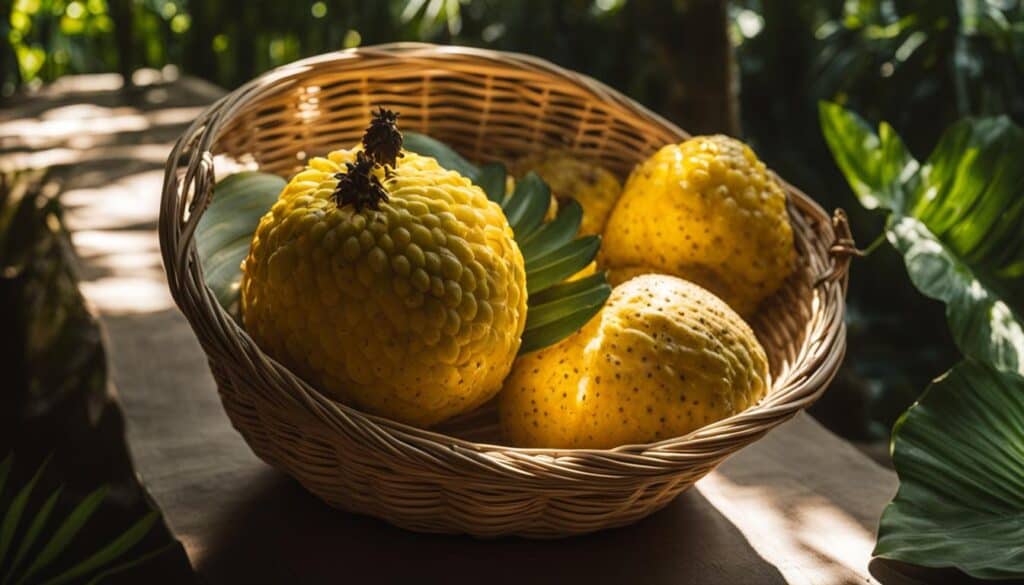
The Taste of Marang: A Symphony of Flavors
The taste of marang is akin to a symphony of flavors. As you bite into the fruit, your taste buds are treated to a medley of sweetness that combines the essence of banana, pineapple, and jackfruit. It is this unique combination that sets marang apart from other tropical fruits.
How to Eat Marang: A Tropical Delight
When it comes to enjoying marang, simplicity is key. Start by removing the thick, green outer skin of the fruit. Then, take a spoon or your fingers and dive into the creamy flesh of the fruit. Each bite will be a tropical delight, with the sweetness of the fruit enveloping your senses. Whether enjoyed on its own or incorporated into various recipes, marang is sure to leave you craving more.
| Benefit | Explanation |
|---|---|
| Vitamins and Minerals | Marang is rich in essential vitamins and minerals, including vitamin C and B6, potassium, and dietary fiber. |
| Healthy Digestion | The high fiber content of marang promotes healthy digestion and can help prevent constipation. |
| Antioxidant Properties | Marang contains antioxidants that protect the body against oxidative stress and reduce the risk of chronic diseases. |
| Low in Calories and Fat | Marang is a healthy choice for those watching their weight as it is low in calories and fat. |
“The taste and texture of marang are truly exceptional. It’s like taking a bite of paradise with each mouthful.” – Fruit Enthusiast
Health Benefits of Marang
The marang fruit is not only a delicious tropical delicacy, but it also offers a wide range of health benefits. Rich in vitamins and minerals, marang is a nutritious addition to any diet. Here are some of the key health benefits of marang:
- High in Vitamin C: Marang is a great source of vitamin C, which is known to boost the immune system and promote healthy skin.
- Rich in Dietary Fiber: The fruit contains a significant amount of dietary fiber, which aids in digestion and helps to prevent constipation.
- Good Source of Potassium: Marang is a good source of potassium, an essential mineral that helps regulate blood pressure and maintain heart health.
- Antioxidant Properties: Marang contains antioxidants that help protect the body against oxidative stress and reduce the risk of chronic diseases.
These health benefits make marang a valuable addition to a balanced diet. Whether enjoyed on its own or incorporated into various dishes and desserts, marang can provide a tasty and nutritious boost to your overall health.
| Nutrient Content | Amount per 100g |
|---|---|
| Calories | 68 |
| Protein | 0.9g |
| Carbohydrates | 16.5g |
| Fiber | 1.8g |
| Fat | 0.3g |
| Potassium | 256mg |
| Vitamin C | 20.9mg |
As seen in the table above, marang is low in calories and fat, making it a healthy choice for those watching their weight. It is also a good source of fiber, which aids in digestion and promotes feelings of fullness. Additionally, marang contains a moderate amount of potassium and vitamin C, both of which are essential for overall health and well-being.
The Marang Tree and Its Habitat
The marang tree, scientifically known as Artocarpus odoratissimus, is a native tree of the Philippines. It belongs to the Moraceae family and is closely related to jackfruit and breadfruit. The tree is tall and evergreen, with large, glossy leaves. It prefers a tropical climate and can be found growing in the lowland areas of the Philippines.
The marang tree produces round fruits that grow to about the size of a melon. The fruits have a green outer skin and a soft, creamy flesh. The tree requires well-drained soil and plenty of sunlight to thrive. In the Philippines, marang trees are commonly found in backyard gardens, orchards, and even in the wild.
The marang tree plays a vital role in the ecosystem of the Philippines. It provides shade and habitat for various birds and animals. The fruit serves as a food source for wildlife, contributing to the biodiversity of the region. Additionally, the marang tree has cultural significance in the Philippines, as it is associated with abundance and fertility.
“The marang tree is not just a source of delicious fruit, but also an important part of Filipino culture and the ecosystem.”
| Characteristics of the Marang Tree | Habitat Requirements |
|---|---|
| Tall and evergreen | Tropical climate |
| Large, glossy leaves | Well-drained soil |
| Produces round fruits | Plenty of sunlight |
| Green outer skin, creamy flesh | Lowland areas of the Philippines |
The marang tree is a valuable asset in the Philippines’ agricultural landscape. Its fruit provides nourishment and economic opportunities for local farmers. By supporting the cultivation of marang trees, we can contribute to sustainable agriculture and the preservation of traditional farming practices.

Experience the beauty of marang and the lush habitat of the Philippines by visiting the country during the marang season. Discover the magic of this tropical fruit and immerse yourself in its cultural and ecological significance.
The Cultural Significance of Marang in the Philippines
Marang holds a special place in Filipino culture, representing more than just a tropical fruit. It is deeply ingrained in Filipino cuisine and traditional practices, making it a symbol of heritage and identity. Marang is often enjoyed during family gatherings and special occasions, bringing people together to celebrate and savor its unique flavors.
In Filipino cuisine, marang is a prized ingredient used in various dishes and desserts. One popular dessert that showcases marang’s deliciousness is halo-halo, a colorful mix of fruits, jellies, beans, and shaved ice topped with evaporated milk. Marang adds a creamy and sweet touch to this refreshing dessert, creating a harmonious blend of flavors.
Aside from its culinary significance, marang also plays a role in traditional medicine. It is believed to have medicinal properties and is used to treat ailments such as diarrhea and stomach problems. Its healing powers have been passed down through generations, with the fruit being used as a natural remedy by Filipino healers.
“Marang is not just a fruit; it’s a part of our identity and traditions. It connects us to our roots and reminds us of the rich cultural heritage of the Philippines.” – Chef Maria Santos
Furthermore, marang is deeply intertwined with the concept of abundance and fertility in Filipino culture. It is seen as a symbol of prosperity and good fortune, representing the bountiful blessings that nature provides. This symbolism is often reflected in traditional festivities and rituals, where marang takes center stage as an offering to deities or as a decoration during celebrations.
Overall, marang’s cultural significance in the Philippines goes beyond its taste and nutritional value. It represents the deep connection between the Filipino people and their natural surroundings, their traditions, and their sense of community.
Table: Traditional Filipino Dishes and Desserts Made with Marang
| Dish/Dessert | Description |
|---|---|
| Halo-Halo | A popular dessert made with a mix of fruits, jellies, beans, and shaved ice topped with evaporated milk. Marang adds a creamy and sweet flavor to this refreshing treat. |
| Leche Flan with Marang Sauce | A classic Filipino dessert made with caramelized sugar and egg yolks, served with a luscious marang sauce. The combination of velvety flan and creamy marang sauce is a match made in dessert heaven. |
| Ginataang Marang | A savory dish made with marang cooked in coconut milk, garlic, onions, and spices. It is commonly enjoyed as a main course or as a side dish. |
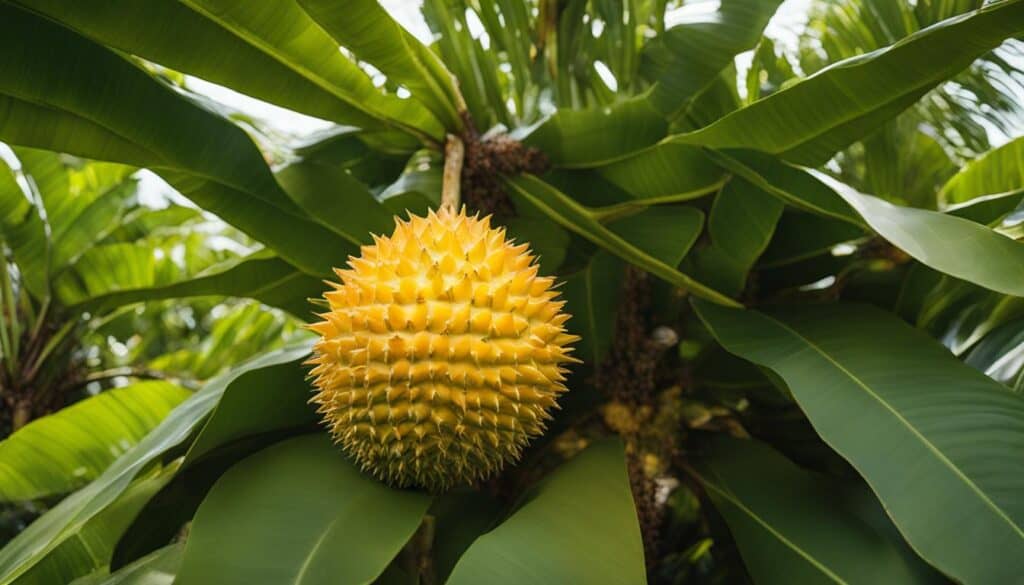
Availability and Seasonality of Marang
Marang, the exotic tropical fruit, is a seasonal delight that can be enjoyed in the Philippines from June to September. During this time, the marang trees bear fruit, and the markets are filled with fresh and succulent marang. It is important to note that marang has a short shelf life and is highly perishable, which is why it is not commonly found in international markets. To truly experience the unique flavors of marang, it is best to indulge in it when it is freshly harvested and at its peak of ripeness.
In the Philippines, tourists visiting during the marang season have the opportunity to taste this tropical delicacy and immerse themselves in its rich and creamy goodness. The availability of marang during this time brings a buzz of excitement among locals and tourists alike, as they eagerly await the arrival of this tropical fruit paradise.
Unfortunately, due to its limited availability and short season, marang is not accessible year-round. Therefore, it is a special treat that should be savored and enjoyed during its peak season in the Philippines. If you happen to be in the country during the marang season, be sure to seize the opportunity to relish the flavors of this delectable tropical fruit.
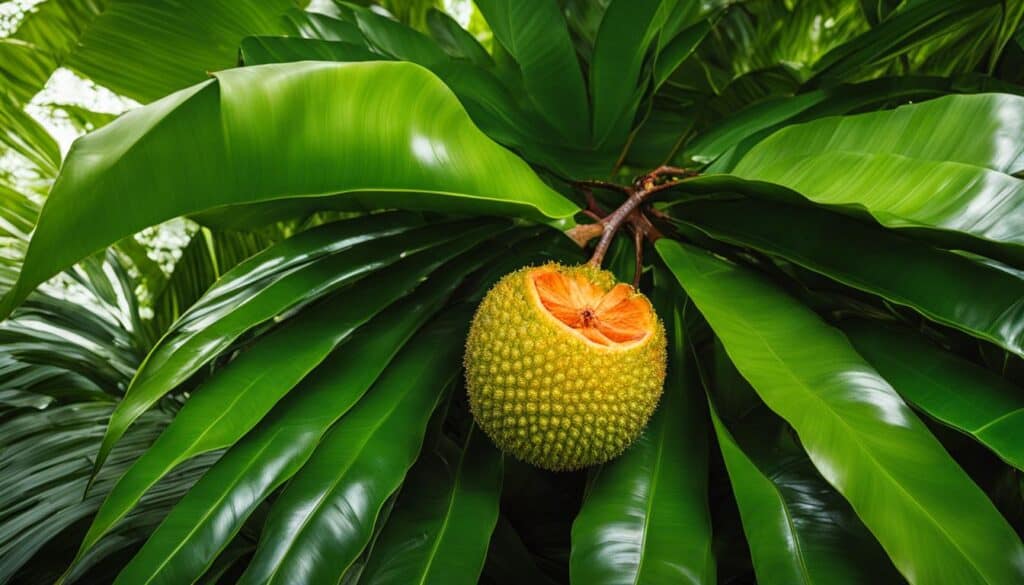
Marang: A Delight for Fruit Enthusiasts
Marang is a true delight for fruit enthusiasts like myself. Its unique taste and texture make it a favorite among those of us who enjoy trying new and exotic fruits. The sweet and creamy flesh of marang provides a burst of flavor with every bite, making it a truly satisfying fruit to indulge in.
Not only does marang taste delicious, but it also offers numerous health benefits. It is a good source of vitamins and minerals, including vitamin C, vitamin B6, potassium, and dietary fiber. These nutrients play a vital role in supporting overall health and well-being.
Whether you eat marang on its own, blend it into a smoothie, or use it in desserts, this tropical fruit is sure to satisfy any fruit lover’s cravings. So go ahead and give marang a try – you won’t be disappointed!
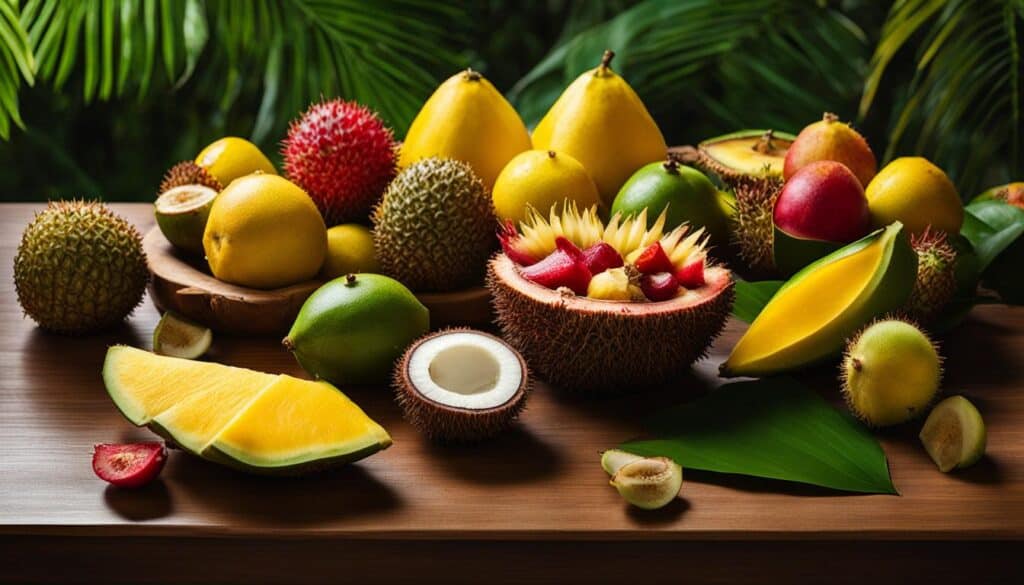
| Marang Taste Profile | Description |
|---|---|
| Taste | Sweet and fragrant, with flavors of banana, pineapple, and jackfruit. |
| Texture | Creamy and soft, similar to the texture of custard. |
| Usage | Can be eaten on its own, blended into smoothies, added to fruit salads, or used as a topping for ice cream. |
As you can see, marang offers a delightful taste and texture that is truly unique. Its nutritional benefits further add to its appeal, making it a guilt-free indulgence. So, if you’re a fruit enthusiast like me, be sure to give marang a try and experience the magic for yourself!
Experiencing Marang in the Philippines
To fully immerse yourself in the delightful flavors of marang, a trip to the Philippines is a must. This tropical paradise is where marang is cultivated and enjoyed, offering a truly authentic experience for fruit enthusiasts. When you visit the Philippines, you’ll find marang in abundance at local markets, fruit stalls, and even roadside stands.
To savor the unique taste and texture of marang, simply peel off the green skin to reveal the sweet and creamy flesh within. Each bite is a burst of flavor that combines the tropical goodness of pineapple, banana, and jackfruit. The velvety smoothness and delicate sweetness of marang make it a true tropical delight.
As you indulge in the succulent flesh of marang, take a moment to appreciate the cultural significance of this fruit in the Philippines. It’s a symbol of abundance and fertility, deeply rooted in Filipino cuisine and traditional practices. From family gatherings to special occasions, marang is a cherished ingredient in various Filipino dishes and desserts. Beyond its culinary importance, marang also holds medicinal properties and is used in traditional medicine to treat stomach problems and diarrhea.
How to Eat Marang
There are various ways to enjoy marang. You can eat it fresh, blend it into smoothies, add it to fruit salads, or use it as a topping for ice cream. Its versatility allows you to explore different culinary creations and discover your preferred way of indulging in this tropical fruit. So, when you find yourself in the Philippines during the marang season, be sure to seize the opportunity to experience the magic of marang firsthand.
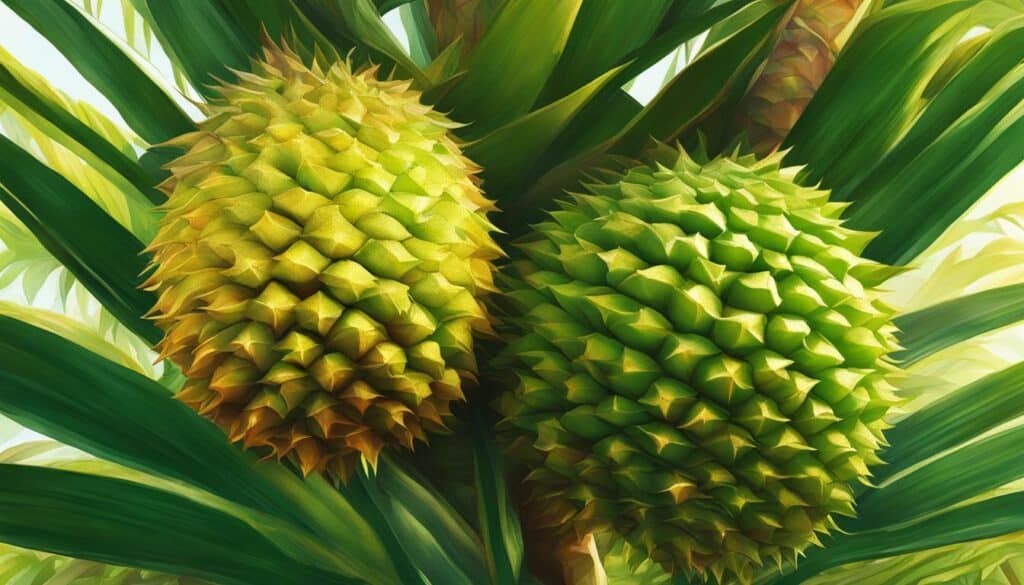
| How to Eat Marang | Tips |
|---|---|
| Eat it fresh | Peel off the green skin and enjoy the sweet and creamy flesh. |
| Blend into smoothies | Add marang to your favorite smoothie recipe for a tropical twist. |
| Add to fruit salads | Slice marang and mix it with other tropical fruits for a refreshing salad. |
| Top off ice cream | Use marang as a delicious and unique topping for your favorite ice cream flavor. |
Growing Popularity of Marang Outside the Philippines
The unique taste and texture of marang are attracting fruit enthusiasts and adventurous eaters from around the world, leading to the growing popularity of this tropical delicacy beyond the borders of the Philippines. With its sweet and creamy flesh reminiscent of a custard-like texture, marang offers a truly delightful eating experience that appeals to those seeking new and exotic flavors.
The increasing demand for marang has resulted in the cultivation of marang trees in tropical regions outside the Philippines. Fruit lovers and garden enthusiasts are planting marang trees in their gardens and orchards to enjoy the rich flavor and unique qualities of this tropical fruit. As more people discover the pleasures of marang, its popularity continues to rise, making it a sought-after fruit for those looking to expand their culinary horizons.
While marang may not yet be as widely available outside the Philippines as it is within the country, its growing popularity is a testament to its appeal. As more people become aware of the delicious taste and texture of marang, it is likely that its availability in markets and grocery stores worldwide will continue to increase, allowing enthusiasts to enjoy this tropical fruit no matter where they are.
Table: Comparison of Marang with Other Tropical Fruits
| Tropical Fruit | Taste | Texture | Availability |
|---|---|---|---|
| Marang | Sweet and fragrant, similar to a combination of banana, pineapple, and jackfruit | Soft and creamy, reminiscent of custard | Primarily cultivated in the Philippines; growing popularity outside the country |
| Jackfruit | Sweet and tropical with a subtle tang | Firm and fibrous, similar to pulled pork | Widely available in tropical regions and international markets |
| Breadfruit | Starchy and mildly sweet | Dense and creamy, similar to a potato | Commonly found in tropical regions, limited availability outside |
As shown in the table above, marang offers a unique taste and texture compared to other tropical fruits like jackfruit and breadfruit. Its growing popularity outside the Philippines is a testament to its distinct qualities and increasing appeal. Whether you have the chance to enjoy marang in the Philippines or discover it in your local market, this tropical fruit is sure to delight your taste buds with its exotic flavors and creamy goodness.
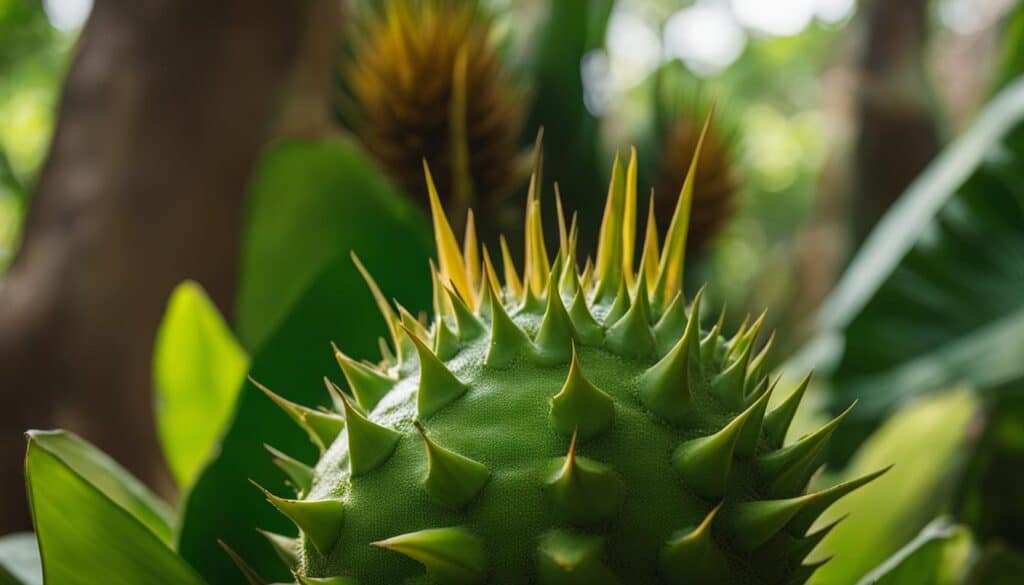
Supporting Local Farmers and Sustainable Agriculture
When it comes to supporting local farmers and promoting sustainable agriculture, embracing marang can make a significant difference. Marang, with its numerous benefits and the value it brings to various communities, has the potential to contribute to the preservation of traditional farming practices and the livelihoods of farming communities.
Growing marang and other tropical fruits provides farmers with a sustainable source of income. By cultivating marang trees, farmers can diversify their crops and tap into a market that appreciates the unique taste and nutritional benefits of this tropical fruit. This not only helps local farmers financially but also encourages the preservation of traditional farming methods that have been passed down through generations.
Furthermore, marang trees have proven to be valuable assets in sustainable agriculture efforts. These trees are known for their ability to improve the quality of soil and restore its fertility. By planting marang trees, farmers can contribute to the long-term sustainability of their land, ensuring that future generations can continue to enjoy the benefits of this tropical fruit.
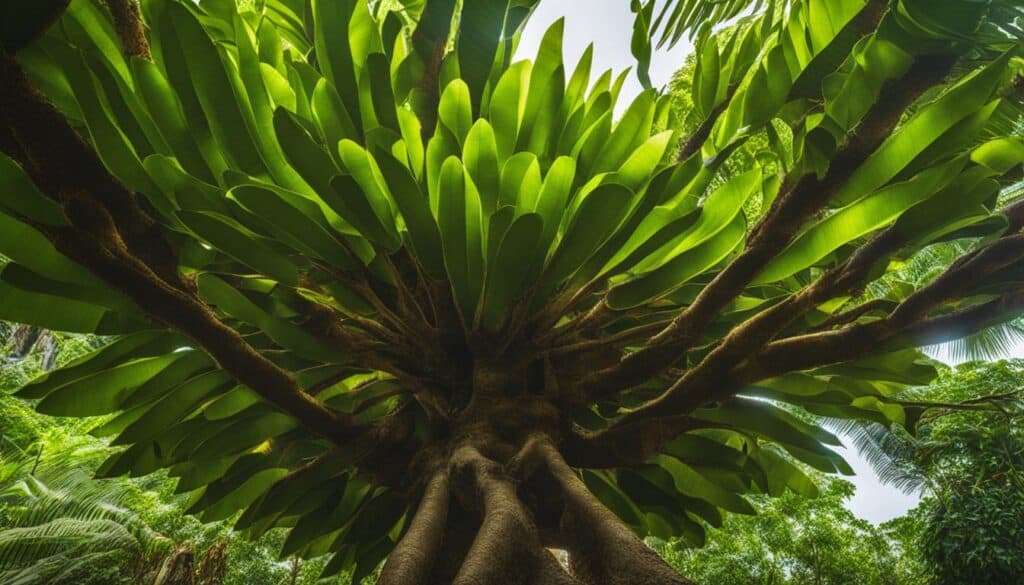
Table: Comparison of Marang and Other Tropical Fruits
| Criteria | Marang | Jackfruit | Breadfruit |
|---|---|---|---|
| Taste | Sweet and creamy | Sweet and fibrous | Mild and starchy |
| Nutritional Value | Rich in vitamins and minerals | High in dietary fiber | Good source of carbohydrates |
| Cultivation | Grown primarily in the Philippines | Grown in tropical regions worldwide | Grown in tropical regions worldwide |
By embracing marang and other tropical fruits, we not only support local farmers and sustainable agriculture but also get to experience the unique flavors and benefits they offer. Whether enjoyed fresh or used in various recipes, marang is a fruit that brings joy and nourishment. So let’s celebrate and appreciate the marang tree, its delicious fruits, and the positive impact they have on our communities and the environment.
Conclusion
Marang is an exotic tropical fruit that has captured the hearts and taste buds of fruit enthusiasts around the world. Its sweet and creamy flesh, reminiscent of banana, pineapple, and jackfruit, provides a burst of unique flavors with every bite. Not only is marang delicious, but it also offers numerous health benefits. Packed with essential vitamins and minerals, including vitamin C and potassium, marang supports overall health and promotes healthy digestion.
Visiting the Philippines during the marang season is a must for any fruit lover. Local markets and fruit stalls offer fresh marang, allowing you to experience the fruit at its peak of ripeness. There’s nothing quite like peeling off the green skin and savoring the creamy flesh directly. The cultural significance of marang in the Philippines adds an extra layer of appreciation and enjoyment.
In recent years, marang’s popularity has spread beyond the Philippines, catching the attention of fruit enthusiasts and adventurous eaters worldwide. As a result, marang trees are now being cultivated in tropical regions outside the Philippines to meet the growing demand. By embracing marang and supporting local farmers, we can contribute to sustainable agriculture practices and the preservation of traditional farming methods.
So, whether you’re in the Philippines or exploring new culinary horizons, make sure to add marang to your list of must-try fruits. Its exquisite taste, health benefits, and cultural significance make it a tropical fruit paradise worth indulging in.
FAQ
Q: What does marang taste like?
A: Marang has a unique taste that combines flavors of banana, pineapple, and jackfruit. It is sweet and fragrant with a creamy texture.
Q: How do you eat marang?
A: To eat marang, you need to remove the thick green skin and enjoy the sweet and creamy flesh of the fruit.
Q: What health benefits does marang offer?
A: Marang is a good source of vitamins and minerals, including vitamin C, vitamin B6, potassium, and dietary fiber. It promotes healthy digestion and provides antioxidants to protect against chronic diseases.
Q: Where is the marang tree native to?
A: The marang tree is native to the Philippines.
Q: How is marang significant in Filipino culture?
A: Marang is deeply ingrained in Filipino cuisine and is used in various dishes and desserts. It is also believed to have medicinal properties and is considered a symbol of abundance and fertility.
Q: When is marang available in the Philippines?
A: Marang is typically available in the Philippines from June to September.
Q: What makes marang a delight for fruit enthusiasts?
A: The unique taste and creamy texture of marang make it a favorite among fruit lovers.
Q: How can I experience marang in the Philippines?
A: When in the Philippines, you can find marang in local markets, fruit stalls, and roadside stands. Simply peel off the green skin and enjoy the sweet and creamy flesh.
Q: Is marang gaining popularity outside the Philippines?
A: Yes, the unique taste and texture of marang have caught the attention of fruit enthusiasts worldwide, leading to its cultivation in tropical regions outside the Philippines.
Q: How can marang support local farmers and sustainable agriculture?
A: By supporting local farmers who grow marang and other tropical fruits, consumers can contribute to the preservation of traditional farming practices and the livelihoods of farming communities. Marang trees also improve the quality of soil, making them valuable assets in sustainable agriculture efforts.
Q: What is the conclusion about marang?
A: Marang is an exotic tropical fruit with a unique taste and numerous health benefits. It is deeply rooted in Filipino culture and offers a delightful culinary experience. Experiencing marang in the Philippines and supporting local farmers can contribute to sustainable agriculture and the preservation of traditional farming practices.

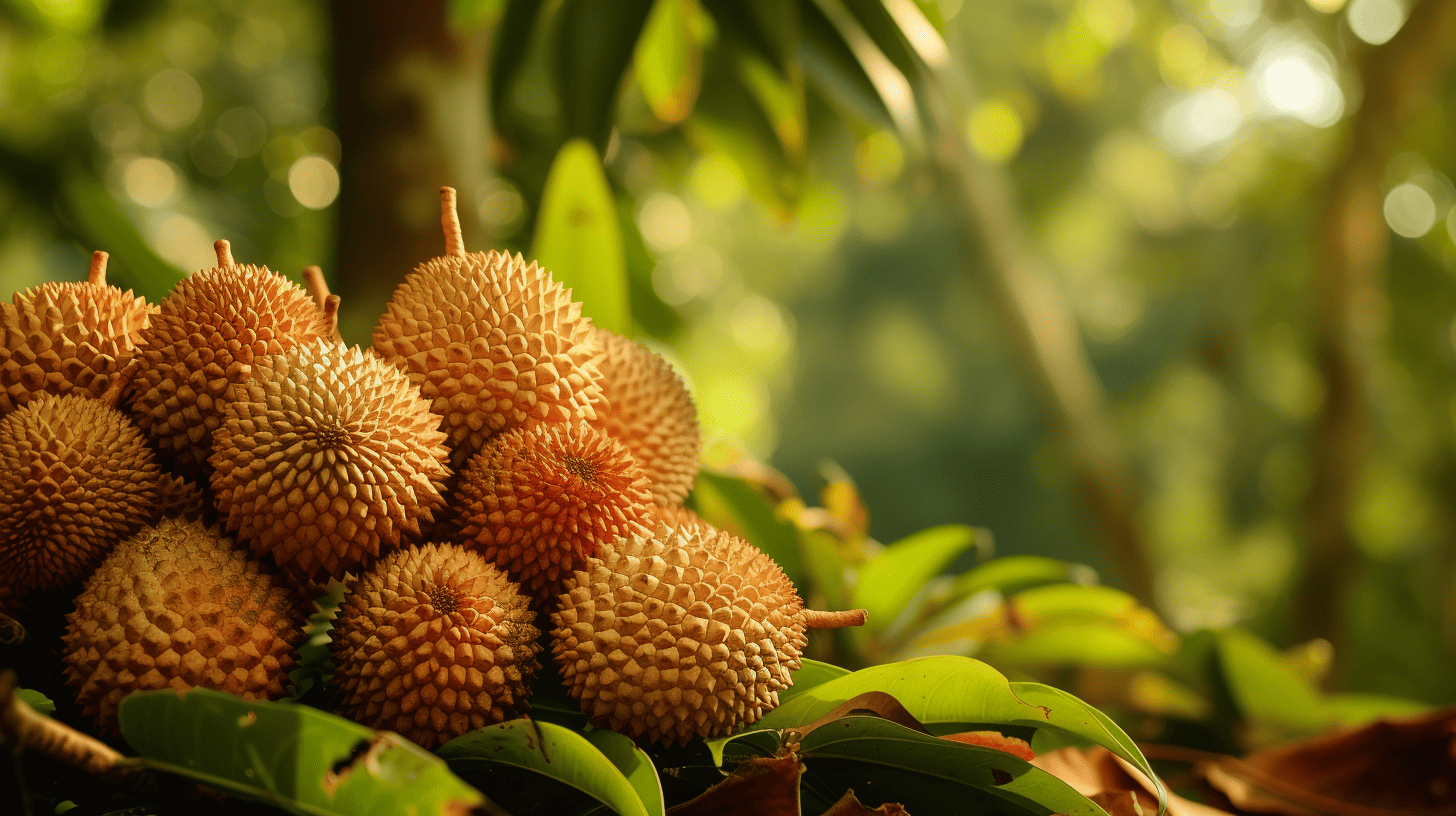



Leave a Reply